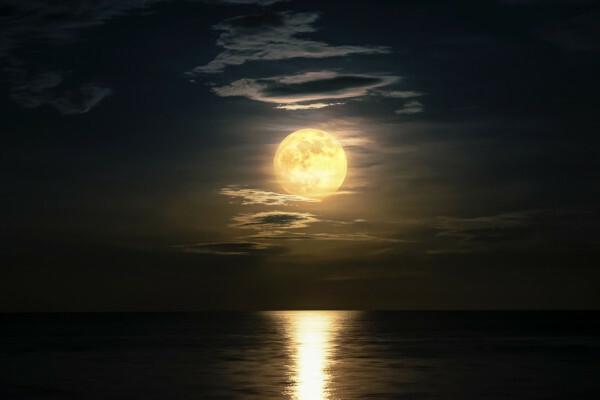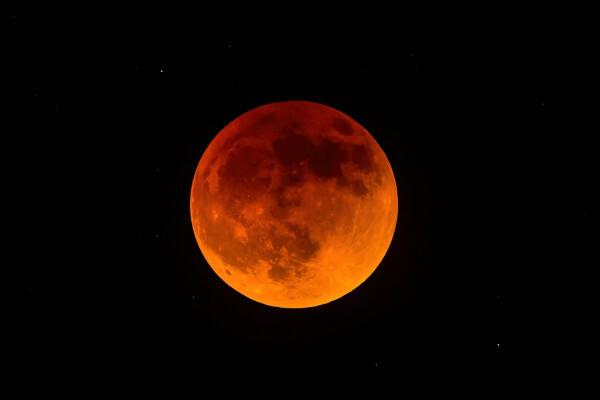Blue Moon It is an astronomical phenomenon characterized by the occurrence of a second full moon within the same calendar month. It is an occurrence that is repeated every two to three years, which is directly related to the time of completion of the lunar cycles.
Unlike what happens in cases like the blood moon, on the blue moon, Earth's natural satellite does not appear to have a bluish color. This only happens in rare situations. Overall, it features the same color as every full moon. The next Blue Moon will occur on the night of August 30, 2023 and will also be a supermoon.
Read too: What are the phases of the Moon?
Topics of this article
- 1 - Summary about the Blue Moon
- 2 - When does the Blue Moon occur?
- 3 - Characteristics of the Blue Moon
- 4 - Why is the Blue Moon rare?
- 5 - Blue moon in 2023
- 6 - Dates of the next Blue Moons
- 7 - Phenomena that alter the color of the Moon
- 8 - Meanings of the Blue Moon
- 9 - Curiosities about the Blue Moon
Summary about the Blue Moon
Blue moon is an astronomical phenomenon characterized by the occurrence of a second full moon in a month.
There is also the seasonal blue moon, the name given to the third full moon of a season.
The occurrence of a Blue Moon varies between two and three years.
Its occurrence is directly related to the duration of the lunar cycle, which is 29.5 days.
Despite its name, the Blue Moon does not have a bluish color. Only in rare cases, such as large volcanic eruptions, do we perceive the Moon with a different color.
The Blue Moon of 2023 will also be a supermoon. It will be visible in the skies around the world from the 30th of August.
This phenomenon has a strong religious and mystical meaning.
When does the Blue Moon occur?
According to to NASA, the blue moon is an astronomical phenomenon that occurs every two or three years, It ism as a function of cycle time from the Lwow.
Each of the lunar cycles lasts not exactly a month, but 29.5 days. Thus, the 12 cycles of the Moon recorded in a year last approximately 354 days, less than the total number of days in the calendar we use. Therefore, in each period (generally two or three years), it is possible to observe the occurrence of two full moons in the same month. A second LThe full month of the month is called the Blue Moon. In this case, the Blue Moon is classified as calendar.
There is also the seasonal Blue Moon. This type corresponds to the third full moon among the four that happen in a given season. On rare occasions, the seasonal Blue Moon can occur in conjunction with the calendar, that is, in the same year.
Do not stop now... There's more after the publicity ;)
Characteristics of the Blue Moon
The Blue Moon is nothing more than the second full Moon that occurs within a period of 30 days. It is said that if a full moon occurs on the first or second day of the month, there is a great possibility that a new full moon will occur before the end of the month, this being the blue moon. For this reason, the Blue Moon usually appears in months with 31 days.
Due to the difference in time zones and calendar time counting, it is possible that not all places in the world have the phenomenon of the blue moon on the same day.
Although the phenomenon has this name, when we observe the natural satellite, we will not see it in a bluish color. Its appearance is the same as every full moon, except when it happens at the same time as one shigherlwow, when it has a yellowish tinge.
In the past, some natural phenomena, such as large volcanic eruptions, temporarily altered the atmospheric composition of regions of the planet Earth and made people see the Moon in blue, but this is not the way this phenomenon is usually seen. it happens. The name Blue Moon is related to the rarity of its appearance.
English speakers have an expression that says: once in a blue moon, which means something that happens every blue moon, denoting a rare but not impossible event. This expression is referred to as the origin of the name Blue Moon for the astronomical phenomenon.
Why is the Blue Moon rare?
The blue moon is rare because it is not common to have the occurrence of two Ltwo floods in the same month. This only happens at intervals of time that can vary between two and three years, depending on the time of the lunar cycle.
Blue moon in 2023

the blue moon to happená once in the year 2023, after two years of its last occurrence, in 2021. The phenomenon of 2023 can be considered even rarer than the usual blue moon, because we will simultaneously have the supermoon. A supermoon happens when, in its full phase, the Moon is closest to Earth and appears to be bigger and brighter.
The Blue Moon of 2023 will appear in the skies on August 30th, and will be visible in all countries. It is estimated that it will be visible from 22:35, at Brasilia Time.
Dates of the next Blue Moons
The next seasonal Blue Moon is expected to happen between the 19th and 20th of August 2024. The next calendar Blue Moons are predicted for the following dates:
May 31, 2026;
December 31, 2028;
September 30, 2031;
July 31, 2034.
It is estimated that, in 2037, and even in 2048, we will have the appearance of two Blue Moons in the same year.
Phenomena that change the color of the Moon

The coloration of the Moon itself does not change, but the way we perceive it from the Earth's surface does. During the phenomenon known as moon of sblood, for example, we see the natural satellite larger than normal and in reddish tones, which happens due to the total lunar eclipse.
In the same way, Theevents on planet Earth may cause changes in the color of the Moon, such as wildfires of great magnitude and the eruption of large volcanoes that introduce many new particles of smoke and dust into the atmosphere.
In 1883, with the eruption of the Indonesian volcano Krakatoa, and, in 1983, with the eruption of El Chichón, in Mexico, it was possible to observe the Moon, blue, in fact, because materials suspended in the atmosphere scattered red light, allowing us to see at other wavelengths. wave.|1|
See too: What is the far side of the Moon?
blue moon meanings
Many cultures and religious strands believe that the Blue Moon has a symbolic and mystical meaning, linked or not to the dynamics of nature.
For certain Native American peoples, the blue moon that happens in January is called Wolf Moon or the Wolf Moon. They call it that because during this time of year, mid-winter, wolves become more vulnerable and approach other animals and people due to their need to get food.
There are also spiritual and mystical interpretations that understand the period of the Blue Moon as a time of focus, clarity, intuition and self-knowledge so that individuals can elevate their thoughts on their goals and draw plans in a way effective.
Facts about the Blue Moon
The definition most used today for Blue Moon came from a misinterpretation by James Hugh Pruett (1886-1955) in 1946.
The August Blue Moons are known in some parts of the United States as the Sturgeon Moon, due to the population of this type of fish that settles in the Great Lakes at that time of year.
Sources
ASSOCIATED PRESS. August will have a rare blue moon, after two supermoons. G1, 2023. Available in: https://g1.globo.com/ciencia/noticia/2023/07/29/agosto-tera-uma-rara-lua-azul-apos-duas-superluas.ghtml.
DOBRIJEVIC, Daisy. blue moon: What is it and when is the next one? Space, 2023. Available in: https://www.space.com/15455-blue-moon.html.
G1. Blue Moon: understand why we will have an original 'Blue Moon' on Sunday, even without the color change. G1, 2021. Available in: https://g1.globo.com/ciencia-e-saude/noticia/2021/08/20/lua-azul-entenda-porque-teremos-no-domingo-uma-blue-moon-original-mesmo-sem-a-mudanca-de-cor.ghtml.
JOHNSTON, Gordon. The Next Full Moon is a Supermoon and a Blue Moon. NASA, 2023. Available in: https://solarsystem.nasa.gov/news/2367/the-next-full-moon-is-a-supermoon-and-a-blue-moon/.
MCCLURE, Bruce; BYRD, Deborah. Blue moon? What is it and when is the next one? Earth Sky, 2023. Available in: https://earthsky.org/astronomy-essentials/when-is-the-next-blue-moon/.
PHILLIPS, Tony. blue moon. NASA, 2004. Available in: https://www.nasa.gov/vision/universe/watchtheskies/07jul_bluemoon.html.
ROYAL MUSEUMS GREENWICH. What is a blue moon? Available in: https://www.rmg.co.uk/stories/topics/what-blue-moon-how-often-does-it-occur.
SOUZA, Amanda. Only 4 days left for the rare 'Blue Moon' to happen! Learn more about the beautiful phenomenon and who will be able to observe it. Meteored, 2023. Available in: https://www.tempo.com/noticias/actualidade/faltam-apenas-4-dias-para-a-rara-lua-azul-acontecer-saiba-mais-sobre-o-belo-fenomeno-e-quem-podera-observa-lo.html.
Do you know what the phases of the moon are? Click here, get to know each one of them and find out how the moon participates in eclipses.
Do you know how the Moon formed? Read our text and learn everything about the natural satellite of planet Earth! Learn about the characteristics and different phases of the Moon.
Learn how and when the Blood Moon occurs, a phenomenon in which the moon has a reddish color.
Click here and understand how the Supermoon phenomenon occurs, which will only happen again in the same way in 2034.


